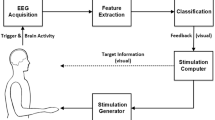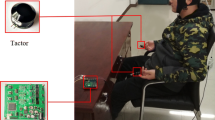Abstract
Purpose
Tactile brain-computer interfaces can be used to express control intentions, avoiding motor imagery difficulties and visual fatigue. Tactile BCI has the problems of poor reproducibility and unclear features in applications. For further applications, a single-trial analysis of tactile-evoked P300 experiments is needed.
Methods
A brain-computer interface for single-trial analysis of vibrotactile stimulation-evoked P300 is proposed. It uses the combination of frequency and time period information as the feature extraction method and uses the maximum value of the most significant EEG channel as the input of the classifier to identify the control intention of the subject and use it to control the lower limb robot.
Results
The online experimental results show that online classification accuracy can reach 89.35 ± 4.86%, which realizes the closed loop of human neural motor rehabilitation. In addition, Subject 9, an elderly person, achieves an online accuracy rate of 83.33%.
Conclusion
A brain-computer interface based on the haptic-evoked P300 is developed and applied to control a lower limb rehabilitation robot. The classification results of an elderly individual verify the feasibility of the method.







Similar content being viewed by others
References
Mrachaczkersting, N., Ning, J., Stevenson, A., Niazi, I. K., Kostic, V., Pavlovic, A., et al. (2016). Efficient neuroplasticity induction in chronic stroke patients by an associative brain-computer interface. Clinical Neurophysiol, 115(3), 1410–1421. https://doi.org/10.1152/jn.00918.2015
Frolov, A. A., Kozlovskaya, I. B., Biryukova, E. V., & Bobrov, P. D. (2018). Use of robotic devices in post-stroke rehabilitation. Neuroscience and Behavioural Physiology, 48(9), 1053–1066. https://doi.org/10.1007/s11055-018-0668-3
Pichiorri, F., & Mattia, D. (2020). Brain-computer interfaces in neurologic rehabilitation practice. Clinical Neurology, 168, 101–116. https://doi.org/10.1016/B978-0-444-63934-9.00009-3
Mrachacz-Kersting, N., Ibáñez, J., & Farina, D. (2021). Towards a mechanistic approach for the development of non-invasive brain-computer interfaces for motor rehabilitation. The Journal of Physiology, 599(9), 2361–2374. https://doi.org/10.1113/JP281314
Wolpaw, J. R., Birbaumer, N., McFarland, D. J., Pfurtscheller, G., & Vaughan, T. M. (2002). Brain-computer interfaces for communication and control. Clinical Neurophysiology, 113(6), 767–791. https://doi.org/10.1016/S1388-2457(02)00057-3
Feng, Z., Sun, Y., Qian, L., Qi, Y., Wang, Y., Guan, C., & Sun, Y. (2021). Design a novel BCI for neurorehabilitation using concurrent LFP and EEG features: a case study. IEEE Transactions on Biomedical Engineering, 69(5), 1554–1563. https://doi.org/10.1109/TBME.2021.3115799
Leoni, J., Strada, S. C., Tanelli, M., Jiang, K., Brusa, A., & Proverbio, A. M. (2021). Automatic stimuli classification from ERP data for augmented communication via brain-computer interfaces. Expert Systems with Applications, 184, 115572. https://doi.org/10.1016/j.eswa.2021.115572
Gao, Q., Dou, L., Belkacem, A. N., & Chen, C. (2017). Noninvasive electroencephalogram based control of a robotic arm for writing task using hybrid BCI system. BioMed Research International, 2017. https://doi.org/10.1155/2017/8316485
Xiao, X., Xu, M., Jin, J., Wang, Y., Jung, T. P., & Ming, D. (2019). Discriminative canonical pattern matching for single-trial classification of ERP components. IEEE Transactions on Biomedical Engineering, 67(8), 2266–2275. https://doi.org/10.1109/TBME.2019.2958641
Chen, X., Chen, Z., Gao, S., & Gao, X. (2014). A high-ITR SSVEP-based BCI speller. Brain-Computer Interfaces, 1(3–4), 181–191. https://doi.org/10.1142/S0129065714500191
Journal of Neural Engineering, 18(6), 066005.http://doi.org/10.1088/1741-2552/ac3044
Chaudhary, U., Birbaumer, N., & Ramos-Murguialday, A. (2016). Brain-computer interfaces for com-munication and rehabilitation. Nature Reviews Neurology, 12(9), 513–525. https://doi.org/10.1038/nrneurol.2017.23
Birbaumer, N., & Cohen, L. G. (2007). Brain-computer interfaces: communication and restoration of movement in paralysis. The Journal of Physiology, 579(3), 621–636. https://doi.org/10.1113/jphysiol.2006.125633
Brunner, P., Joshi, S., Briskin, S., Wolpaw, J. R., Bischof, H., & Schalk, G. (2010). Does the ‘P300’speller depend on eye gaze? Journal of Neural Engineering, 7(5), 056013. https://doi.org/10.1088/1741-2560/7/5/056013
Science Robotics, 4(31), eaaw6844.http://doi.org/10.1126/scirobo-tics.aaw6844
Zhou, Q., Cheng, R., Yao, L., Ye, X., & Xu, K. (2022). Neurofeedback training of alpha relative power improves the performance of motor imagery brain-computer interface. Frontiers in Human Neuroscience, 16. https://doi.org/10.3389/fnhum.2022.831995
Kaufmann, T., Herweg, A., & Kübler, A. (2014). Toward brain-computer interface based wheelchair control utilizing tactually-evoked event-related potentials. Journal of Neuroengineering and Rehabilitation, 11(1), 1–17. https://doi.org/10.1186/1743-0003-11-7
Brouwer, A. M., & Van Erp, J. B. (2010). A tactile P300 brain-computer interface. Frontiers in Neuroscience. https://doi.org/10.3389/fnins.2010.00019. 19.
Chu, C., Luo, J., Tian, X., Han, X., & Guo, S. (2021). A P300 brain-computer interface paradigm based on electric and vibration simple command tactile stimulation. Frontiers in Human Neuroscience, 15, 641357. https://doi.org/10.3389/fnhum.2021.641357
Polich, J. (1986). Attention, probability, and task demands as determinants of P300 latency from auditory stimuli. Electroencephalography and Clinical Neurophysiology, 63(3), 251–259. https://doi.org/10.1016/0013-4694(86)90093-3
Xu, M., Han, J., Wang, Y., Jung, T. P., & Ming, D. (2020). Implementing over 100 command codes for a high-speed hybrid brain-computer interface using concurrent P300 and SSVEP features. IEEE T-ransactions on Biomedical Engineering, 67(11), 3073–3082. https://doi.org/10.1109/TBME.2020.2975614
Clinical EEG and Neuroscience, 45(1), 14–21. http://doi.org/10.1177/1550059413505533
Ortner, R., Lugo, Z., Noirhomme, Q., Laureys, S., & Guger, C. (2014). A tactile brain-computer interface for severely disabled patients. In 2014 IEEE Haptics Symposium (HAPTICS), 235–237. https://doi.org/10.1109/HAPTICS.2014.6775460
Severens, M., Van der Waal, M., Farquhar, J., & Desain, P. (2014). Comparing tactile and visual gaze-independent brain-computer interfaces in patients with amyotrophic lateral sclerosis and healthy users. Clinical Neurophysiology, 125(11), 2297–2304. https://doi.org/10.1016/j.clinph.2014.03.005
Frontiers in Neuroscience, 12, 423.http://doi.org/10.3389/fnins.2018.00423
Cauna, N. (1964). The effect of aging on the receptor organs of the human dermis. Advances in Biology of Skin, 6, 63–96.
Iwasaki, T., Goto, N., Goto, J., Ezure, H., & Moriyama, H. (2003). The aging of human Meissner’s corpuscles as evidenced by parallel sectioning. Okajimas Folia Anatomica Japonica, 79(6), 185–189. https://doi.org/10.2535/ofaj.79.185
Wickremaratchi, M. M., & Llewelyn, J. G. (2006). Effects of ageing on touch. Postgraduate Medical Journal, 82(967), 301–304. https://doi.org/10.1136/pgmj.2005.039651
Han, X., Niu, J., & Guo, S. (2020). A tactile-based brain computer interface P300 paradigm using vibration frequency and spatial location. Journal of Medical and Biological Engineering, 40(6), 773–782. https://doi.org/10.1007/s40846-020-00535-6
Delorme, A., & Makeig, S. (2004). EEGLAB: an open source toolbox for analysis of single-trial EEG dynamics including independent component analysis. Journal of Neuroscience Methods, 134(1), 9–21. https://doi.org/10.1016/j.jneumeth.2003.10.009
Pires, G., Nunes, U., & Castelo-Branco, M. (2012). Comparison of a row-column speller vs. a novel lateral single-character speller: Assessment of BCI for severe motor disabled patients. Clinical Neurophysiology Official Journal of the International Federation of Clinical Neurophysiology, 123(6), 1168. https://doi.org/10.1016/j.clinph.2011.10.040
Mattout, J., Perrin, M., Bertrand, O., & Maby, E. (2015). Improving BCI performance through co-adaptation: applications to the P300-speller. Annals of Physical & Rehabilitation Medicine, 58(1), 23. https://doi.org/10.1016/j.rehab.2014.10.006
Speier, W., Deshpande, A., & Pouratian, N. (2014). A method for optimizing EEG electrode number and configuration for signal acquisition in P300 speller systems. Clinical Neurophysiology, 126(6), 1171–1177. https://doi.org/10.1016/j.clinph.2014.09.021
Akram, F., Han, H. S., & Kim, T. S. (2014). A P300-based brain computer interface system for words typing. Computers in Biology & Medicine, 45(2), 118–125. https://doi.org/10.1016/j.compbiomed.2013.12.001
Akram, F., Han, S. M., & Kim, T. S. (2015). An efficient word typing P300-BCI system using a modified T9 interface and random forest classifier. Computers in Biology and Medicine, 56, 30–36. https://doi.org/10.1109/EMBC.2013.6609985
Liu, Y., Wang, J., Yin, E., Yu, Y., Zhou, Z., & Hu, D. (2019). An tactile ERP-based brain-computer interface for communication. International Journal Of Human–Computer Interaction, 35(7), 559–567. https://doi.org/10.1080/10447318.2018.1471839
Veneman, J. F., Kruidhof, R., Hekman, E. E., Ekkelenkamp, R., Van Asseldonk, E. H., & Van Der Kooij, H. (2007). Design and evaluation of the LOPES exoskeleton robot for interactive gait rehabilitation. IEEE Transactions on Neural Systems and Rehabilitation Engineering, 15(3), 379–386. https://doi.org/10.1109/TNSRE.2007.903919
Acknowledgements
We thank all volunteers for their participation in the study. This work is supported by the Shanghai Science and Technology Innovation Action Plan (21S31902500) and grants from the S&T Program of Hebei (Grant Number 22375001D and 22372001D).
Author information
Authors and Affiliations
Corresponding author
Ethics declarations
Conflict of Interest
The authors declare that there are no conflicts of interest regarding the publication of this paper.
Additional information
Publisher’s Note
Springer Nature remains neutral with regard to jurisdictional claims in published maps and institutional affiliations.
Rights and permissions
Springer Nature or its licensor (e.g. a society or other partner) holds exclusive rights to this article under a publishing agreement with the author(s) or other rightsholder(s); author self-archiving of the accepted manuscript version of this article is solely governed by the terms of such publishing agreement and applicable law.
About this article
Cite this article
Duan, X., Guo, S., Chen, L. et al. A P300 Brain-Computer Interface for Lower Limb Robot Control Based on Tactile Stimulation. J. Med. Biol. Eng. 43, 22–31 (2023). https://doi.org/10.1007/s40846-022-00766-9
Received:
Accepted:
Published:
Issue Date:
DOI: https://doi.org/10.1007/s40846-022-00766-9




